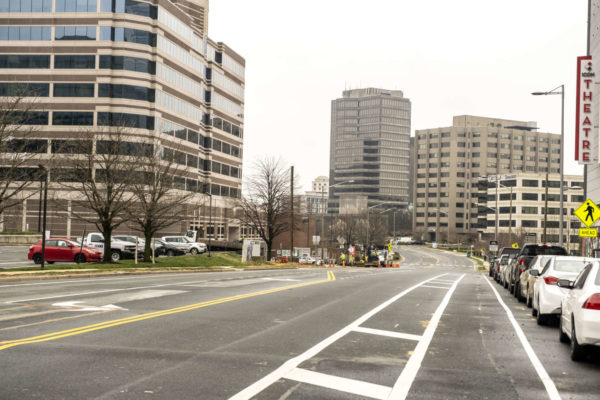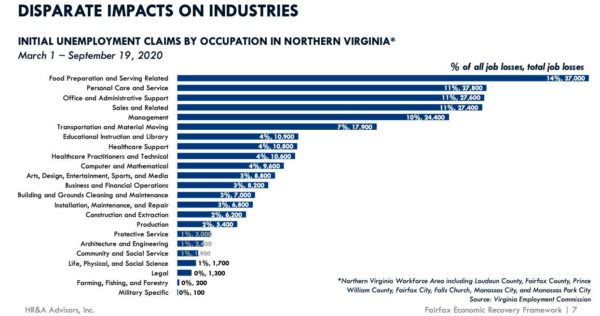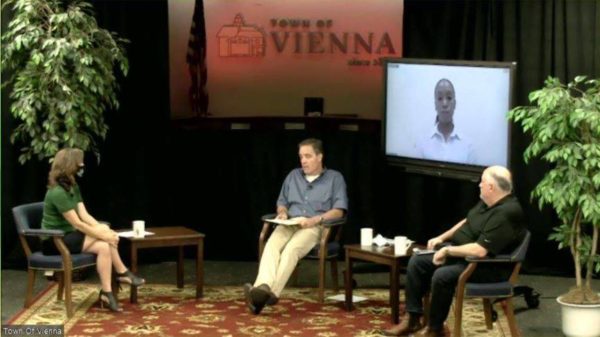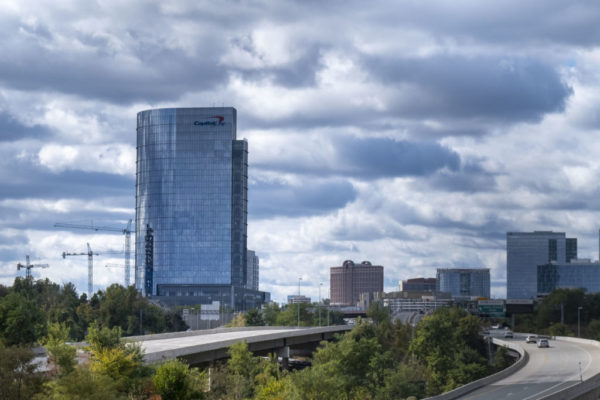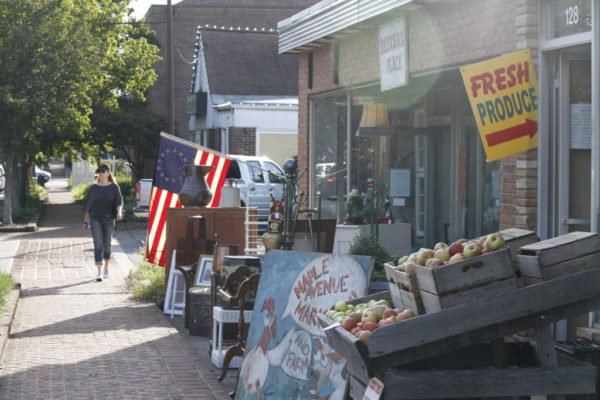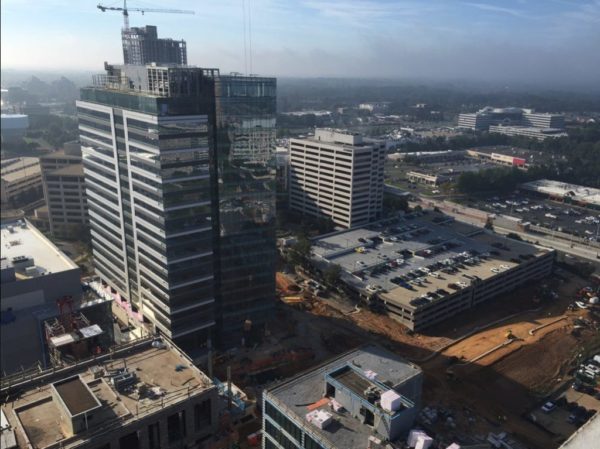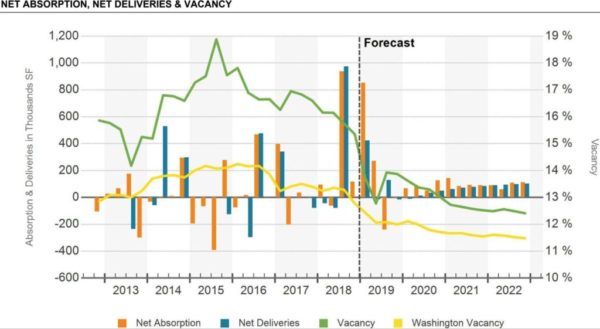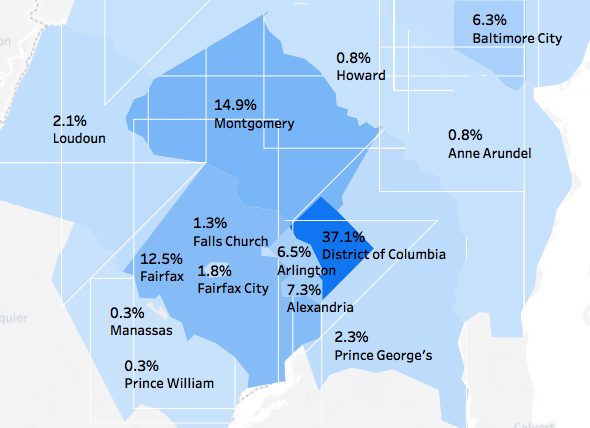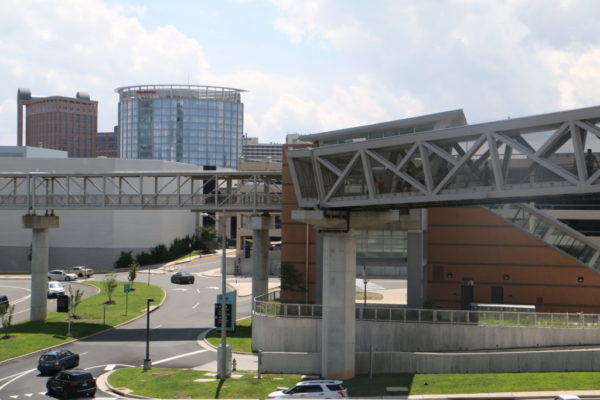A consultant hired by Fairfax County has rounded up some thoughts from regional government, business and non-profit leaders on what was hit most by the pandemic and where the most help is needed.
The feedback is one of the first steps on HR&A’s task of building an Economic Recovery Framework, a recovery strategy commissioned by Fairfax County and the Fairfax County Economic Development Authority.
“This strategy will guide the County through stabilization and outline recommendations for fostering an equitable, inclusive recovery,” HR&A said in a report on the preliminary findings of their study.
In the initial findings, county and civic leaders highlighted the disproportionate impact of the virus on Latino and immigrant populations in Fairfax. The pandemic has also affected access to housing, with lost jobs leaving families without the ability to pay rent.
“Continue to invest in programs that support economic mobility and enrich residents’ lives (job training, continuing education, disability support resources) despite budget shortfalls,” said one unnamed County leader sourced in the findings.
Meanwhile, non-profit and health service providers said their capacity has been under-strain and expect further fundraising challenges in the upcoming year. Suggested solutions mainly involved streamlining services and trying to find efficiencies.
Major employers in the region, meanwhile, said decisions about real estate investments are being deferred until more certainty can be stablished, balanced only by hopes for a more efficient permitting process and a doubling down on tourism and leisure investments.
Smaller employers said they are still struggling with a lack of consumer confidence in returning to businesses and negative impacts have rippled along the supply chain. Many small businesses in the area are still focused on survival. Proposed solutions included more clear safety guidelines, streamlined online permitting, and rent deferment for small businesses.
More analysis of potential recovery scenarios is currently in the works, with a final report being drafted after that.
Staff photo by Jay Westcott
Downtown McLean could see new development over the next 10 years, after Fairfax County adopted a new program last Tuesday making it cheaper and faster for developers to build in revitalization districts.
Developers whose plans meet certain criteria could benefit from real-estate tax breaks, a 10% reduction in site plan fees and a fast-tracked process for zoning applications if they build in McLean, or one of the other five revitalization district in the county.
The Board of Supervisors adopted the Economic Incentive Program on Sept. 15 to give the private sector incentives to revitalize and redevelop properties in a half-dozen commercial revitalization districts, including McLean.
The program was established by an ordinance that amends the county code.
Other qualifying districts include:
- Baileys Crossroads/Seven Corners
- Annandale
- Lincolnia
- Areas along Richmond Highway, including suburban areas and part of the Huntington Transit Station Area
- Springfield, except the single-family portion of the Springfield Transit Station Area
To qualify for the lower costs and faster application processes, developments must be commercial, industrial or multi-family residential. Proposals need to be new and should consolidate at least two neighboring parcels of land totaling at least two acres.
Proposals need to align with the county’s Comprehensive Plan for redevelopment, and follow all laws and policies regarding affordable housing.
Developers will only receive tax breaks for their proposals if they act within the 10-year timeframe specific to their revitalization area. McLean’s window for the tax cut starts on July 1, 2024 and lasts through June 30, 2034.
The county plans to make the application process and forms available later this fall. Those who are interested can connect with county staff and discuss their eligibility by emailing Community Revitalization Section Director Elizabeth Hagg at [email protected].
In a discussion last night (Tuesday) with Vienna Mayor Linda Colbert, several business and economic leaders talked about how locals could show support for their businesses, and how some businesses could do a better job of bringing in customers.
The simplest, and most obvious answer, was for locals to shop local when they can rather than buying through a company like Amazon. Jim Brooke, Town Business Liaison Committee chair, said people should also be more conscious now of taking the time to leave positive reviews online.
“Talk about local businesses on social media, leave positive Yelp reviews for local businesses,” Brooke said. “It’s easy to shop online, but if you want to have brick and mortar businesses in your community, you have to shop at them sometimes.”
Some industries have fared better than others in the pandemic, and Brooke said it’s particularly important to show support for the hardest hit, personal service businesses.
“Construction businesses and real estate have been doing pretty well, but businesses that are more intimate like hair stylists, anything that involves close interaction with people, aren’t doing very well,” Brooke said. “For my business and the people I work with, hospitality industry is really in trouble. Especially caterers, party planners, or party venues.” Read More
(Updated 11/21/19) A recruiting company in Tysons wants to hire hundreds of employees in Tysons — making them the largest job creator in recent months in Fairfax County.
In the third quarter of 2019, the Fairfax County Economic Development Authority announced that 14 companies are adding 456 jobs to the county — including 358 positons in Tysons.
Randstad North America, Inc., an IT recruiting and staffing firm whose parent company is based in the Netherlands, announced they will add 300 information technology jobs in fiscal year 2020.
INADEV, another information technology company, is the runner up for job creation in Tysons for the third quarter by bringing 25 jobs to the area.
Here is the alphabetical list of the rest of the companies bringing jobs into Fairfax County:
- American Office (Chantilly): 10 jobs
- BITS (Herndon): 10 jobs
- Blue Ridge Networks, (Chantilly): 2 jobs
- Bode Cellmark Forensics, Inc. (Lorton): 16
- Chenega MIOS (Chantilly): 16 jobs
- CT Solutions, Inc. (Tysons): 3 jobs
- Global Guardia (Tysons): 15 jobs
- Korea Innovation Center Washington (Korea) (Tysons): 4 jobs
- Learning Tree International, Inc. (Herndon): 25 jobs
- Mathtech, Inc. (Merrifield): 6 jobs
- Signet EV (Korea) (Vienna): 5 jobs
- Sysnet Technologies, Inc. (Fairfax): 10 jobs
Companies in the Tysons area also topped the list for the most added jobs when FCEDA worked with 35 businesses in the second quarter.
Despite a large number of vacancies on Maple Avenue and some recent high profile closures, the Town of Vienna’s Finance Department says twice as many businesses are opening in the town compared to those closing.
Last year, 115 businesses opened and 65 closed, the finance department said, in response to an inquiry from Tysons Reporter.
It’s an optimistic note for a town that, economically, could really use a win.
Last year, Vienna’s commercial vacancy rate was 13 percent. Of the town’s 1,095 commercial properties, 138 were vacant and 68 were on Maple Avenue, according to InsideNova.
But it’s businesses off of Maple Avenue that are being hit the hardest by increasing rents and declining sales. Peggy James, executive director of the Vienna Business Association, said a combination of increasing rents and limited parking availability are making it hard for local businesses to stay afloat.
The Town is taking some steps to make commercial businesses in Vienna more viable, including a plan in the town budget to hire a full-time economic development consultant to focus specifically on ways to make life easier for businesses. Vienna is currently the only Northern Virginia locality without staff tasked specifically with economic development.
In the meantime, here’s a look at some of the more recent businesses to open in Vienna:
Things are getting better for Tysons’ economy, but slowly.
For offices around Tysons, the boom anticipated with the opening of the Metro in 2014 has been more of a trickle as growth continues at a more sluggish pace than initially anticipated.
The Office Submarket Report on Tysons Corner (their wording, not ours) by Ryan Rauner, an associate broker with Realty Markets, shows a market experiencing steady, if unremarkable, growth.
“Despite slow demand growth at the metro level, some has trickled down to Tysons, helping vacancies improve slightly over the past few years,” the report said. “An explosion in the residential population has not yet been matched by strong office-demand growth, despite four Metro stations opening in the submarket.”
While the expansion of the Capital One facility was a welcome boon, the report notes that most tenants are not actively expanding their footprint and there has been a spate of large move-outs, specifically pointing to public affairs consulting group Interel’s decision to leave Tysons for Washington D.C.’s East End Submarket.
Which isn’t to say there haven’t been plenty of new clients coming into Tysons. Apian announced in April it would be moving to Tysons while Cvent announced it would be expanding its local offices. Facebook is also reportedly looking for space at Tysons II to occupy between 75,000-85,000 square feet.
In 2015, office vacancies in Tysons were near 18 percent. Since then, vacancies have steadily fallen to 15.6 percent. Forecasts for the market show vacancies taking a dip in middle-2019 then continuing a steady decline.
The high supply of office and relatively low demand led office rents in Tysons to face a steep decline from 2012-2014. There’s been some growth there, averaging about 2 percent from 2015-2018, but the report also warned not to view that growth as a trend.
“High vacancies could continue weighing on growth,” the report said. “Rents have continued their increase this year but at a relatively slow pace — as of early December, rents had increased by roughly 2 percent for the year. At the metro level, rents surpassed their pre-recession peak in 2015, but those in [Tysons] are just now reaching that point.”
The report did note that Tysons isn’t alone in its lackluster rent growth, that several other locations across Fairfax have also faced similar low rents.
None of this has slowed construction, however. There was 1.2 million square feet of new office space created between 2014-2017. Last year also saw a record high of office space opening with Capital One’s 975,000 square foot expansion.
The report notes that there are two notable projects underway: The Boro and View at Tysons.
The Boro is anticipated to include 582,000 square feet of new office space. Boro Tower, the main office component of the project, is currently 70 percent pre-leased and is expected to be ready sometime this year.
The View at Tysons is further out in development but is expected to include 570,000 square feet of office space and the region’s tallest building as part of a 2.8 million-square-foot mixed-use development.
Auditing giant KPMG LLP will be bringing $30 million dollars and 500 new jobs in a sweeping expansion of its Tysons operations.
KPMG will be moving into seven floors of Boro Tower, part of a massive mixed-use development near the Greensboro Metro station, Virginia Gov. Ralph Northam (D) announced Wednesday morning.
The building, expected to open in early 2019, is a block away from the offices that KPMG currently occupies at 1676 International Drive. That building, in turn, is also set for a substantial renovation.
A $1 million grant from the Commonwealth’s Opportunity Fund was approved by Northam as an economic incentive to facilitate the move. Virginia also offered a slew of other incentives, including a Major Business Facility Job Tax Credit for the new full-time jobs coming with the expansion and employee retraining activities provided by the Virginia Jobs Investment Program.
“We’re committed to Fairfax County and are excited about the growth that we’re seeing here in world-class innovation and leading-edge technology — two areas that align with our own core services and strategic approach,” said Jerry Carlson, a KPMG managing partner, in a press release.
The expansion was also facilitated with local help from the Fairfax County Economic Development Authority (FCEDA) and the Virginia Economic Development Partnership.
“KPMG has been a major employer and corporate citizen in Fairfax County for years, and we are delighted to see that the company has chosen the county as a base to expand its audit, tax and advisory business significantly,” said Gerald Gordon, president and CEO of the FCEDA, in a press release. “This coincides with the continued growth and diversification of the county economy and the increasing realization that this is a great draw for the workforce the company wants to attract and retain.”
“This illustrates our strength in the professional services sector that creates so many jobs here, and is a great vote of confidence in the kind of business community that we promote here,” a FCEDA spokesman added.
Fairfax startups are economically strong but disproportionately tied to the public sector, even compared to other nearby jurisdictions, according to the 2017 Startup Census.
Adam Zuckerman, founder of census creator Fosterly, spoke to the Fairfax County Economic Advisory Commission meeting earlier this month to offer a recap of Fairfax’s role in the survey of local startups.
In total, 48 companies from Fairfax participated in the survey, while 377 businesses from around the region were surveyed in total.
Some findings:
- The Fairfax startups that participated in the survey generated $28 million dollars in revenue in 2017 and projected 194 percent growth in 2018.
- Startups throughout Northern Virginia generated $108 million in revenue and projected 166 percent growth.
- Throughout the entire region, startups generated $193 million in revenue and projected 217 percent growth overall.
- Fairfax County is home to about 12.5 percent of startups in the D.C. area.
According to the survey, startups in Fairfax also derived less of their revenue from consumers or private businesses than the regional average.
- Fairfax startups derived 66 percent of their revenue from private sector customers.
- Regional startups averaged 89 percent revenue from private customers.
“If you look towards the larger set, only 11 percent of revenue in the overall set came from the public sector,” said Zuckerman. “So Fairfax County companies have a disproportionate amount of public sector revenue than the larger ecosystem.”
Ryan Touhill, chief of staff for the Alexandria Economic Development Partnership, said in the survey analysis that the regional shift away from a reliance on the public sector is a positive trend for local economic diversification.
For Fairfax, Zuckerman said this public sector reliance for startups that are generally less than five years old is unusual because most public sector deals require a track record that startups generally don’t have. Most startups, Zuckerman said, start off working in the private sector before dipping their toes into the public sector when the product is proven.
The survey also found that the top five industries in Fairfax for startups were technology and services, computer software, real estate, financial services, and management and consulting.
There was one unfortunate item of news about one company in particular: Fosterly, the company running the census. Unless another organization takes over the mantle, Zuckerman says this year’s census will be the last.
“We’re not doing it again this year,” said Zuckerman. “We’re going to be talking to a few entities to see if they want to continue the census… but the resources weren’t there.”
Photo via Fosterly
Knife Fight in Vienna — “Arriving officers located a man with a laceration to his hand. Witnesses told police the man was trying to break up a fight when one of the combatants pulled a knife, cut the man, then ran off.” [InsideNova]
Fairfax Economic Indicators Look Good — Tax receipts and home prices are up in Fairfax County, while unemployment is down to 2.4 percent. [Fairfax County]
Tysons Company Makes Acquisition — Tysons-based communications firm W2 Communications is acquiring Mesh Omnimedia, a Loudoun County-based creative agency. “This acquisition transforms W2 Communications from a leading public relations and content creation firm, into a full-service communications and branding organization that delivers creative design and digital marketing services,” said a press release. [W2 Communications]


